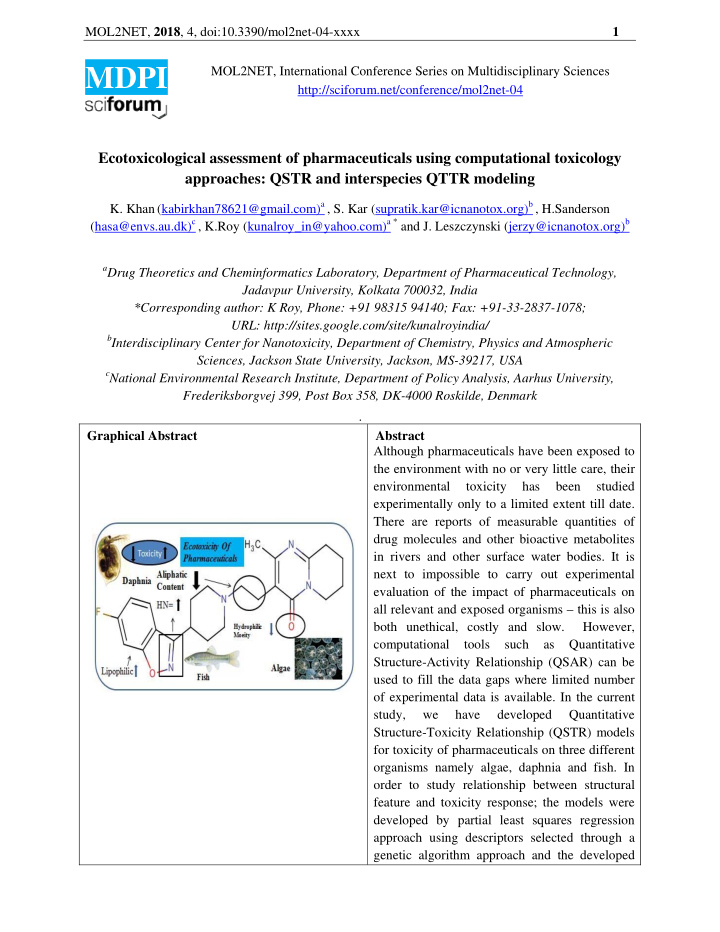



MOL2NET, 2018 , 4, doi:10.3390/mol2net-04-xxxx 1 MDPI MOL2NET, International Conference Series on Multidisciplinary Sciences http://sciforum.net/conference/mol2net-04 Ecotoxicological assessment of pharmaceuticals using computational toxicology approaches: QSTR and interspecies QTTR modeling K. Khan (kabirkhan78621@gmail.com) a , S. Kar (supratik.kar@icnanotox.org) b , H.Sanderson (hasa@envs.au.dk) c , K.Roy (kunalroy_in@yahoo.com) a * and J. Leszczynski (jerzy@icnanotox.org) b a Drug Theoretics and Cheminformatics Laboratory, Department of Pharmaceutical Technology, Jadavpur University, Kolkata 700032, India *Corresponding author: K Roy, Phone: +91 98315 94140; Fax: +91-33-2837-1078; URL: http://sites.google.com/site/kunalroyindia/ b Interdisciplinary Center for Nanotoxicity, Department of Chemistry, Physics and Atmospheric Sciences, Jackson State University, Jackson, MS-39217, USA c National Environmental Research Institute, Department of Policy Analysis, Aarhus University, Frederiksborgvej 399, Post Box 358, DK-4000 Roskilde, Denmark . Graphical Abstract Abstract Although pharmaceuticals have been exposed to the environment with no or very little care, their environmental toxicity has been studied experimentally only to a limited extent till date. There are reports of measurable quantities of drug molecules and other bioactive metabolites in rivers and other surface water bodies. It is next to impossible to carry out experimental evaluation of the impact of pharmaceuticals on all relevant and exposed organisms – this is also both unethical, costly and slow. However, computational tools such as Quantitative Structure-Activity Relationship (QSAR) can be used to fill the data gaps where limited number of experimental data is available. In the current study, we have developed Quantitative Structure-Toxicity Relationship (QSTR) models for toxicity of pharmaceuticals on three different organisms namely algae, daphnia and fish. In order to study relationship between structural feature and toxicity response; the models were developed by partial least squares regression approach using descriptors selected through a genetic algorithm approach and the developed
MOL2NET, 2018 , 4, doi:10.3390/mol2net-04-xxxx 2 models were subsequently extensively validated following OECD guidelines. An additional interspecies quantitative structure-toxicity- toxicity relationship (QSTTR) modelling has been performed to check for the interrelationship of various pattern of response as we move across the hierarchy of genetics in different taxonomical class. Various descriptor calculating software such as PaDEL-Descriptor, DRAGON and SiRMS were used to compute a wide array of 2D descriptors for capturing chemical information required to correlate the biological properties (toxicities) inherited in the chemical structure of the molecules. All the obtained models showed that with an increase in hydrophobic characteristics (in terms of Log P) toxicity also increases linearly while with an increase in hydrogen bond donating groups, toxicity decreases. An applicability domain study was carried out in order to define the scope of developed model and to highlight compounds falling outside the domain of the respective models. The obtained QSTTR models were finally utilized to fill the data gaps of 275 pharmaceuticals, by using as a template to predict toxicity of pharmaceuticals where experimental data were missing for at least one of the endpoints. Finally, the developed QSTR models were used to predict a large dataset of approximately 7000 drug like molecules in order to prioritize the existing drug like substances in accordance to their acute predicted aquatic toxicities. Keywords: QSAR, QSTR, QSTTR, Ecotoxicity, Pharmaceuticals References 1. Ternes, Thomas A. "Occurrence of drugs in German sewage treatment plants and rivers." Water research 32, no. 11 (1998): 3245-3260. 2. Hirsch, Roman, Thomas Ternes, Klaus Haberer, and Karl-Ludwig Kratz. "Occurrence of antibiotics in the aquatic environment." Science of the Total Environment 225, no. 1-2 (1999): 109-118. 3. Sanderson, Hans, and Marianne Thomsen. "Comparative analysis of pharmaceuticals versus industrial chemicals acute aquatic toxicity classification according to the United Nations classification system for chemicals. Assessment of the (Q) SAR predictability of pharmaceuticals acute aquatic
MOL2NET, 2018 , 4, doi:10.3390/mol2net-04-xxxx 3 toxicity and their predominant acute toxic mode-of-action." Toxicology Letters 187, no. 2 (2009): 84- 93. 4. Kar Supratik, Das Rudra Narayan, Roy Kunal, and Leszcznyski, Jerzy, Can Toxicity for Different Species be Correlated?: The Concept and Emerging Applications of Interspecies Quantitative Structure-Toxicity Relationship (i-QSTR) Modeling. Int J Quant Struct-Prop Relat 1, no. 2 (2016): 23-51, http://dx.doi.org/10.4018/IJQSPR.2016070102 5. Das, Rudra Narayan, Kunal Roy, and Paul LA Popelier. "Interspecies quantitative structure– toxicity–toxicity (QSTTR) relationship modeling of ionic liquids. Toxicity of ionic liquids to V. fischeri, D. magna and S. vacuolatus." Ecotoxicology and Environmental Safety 122 (2015): 497-520.
Recommend
More recommend